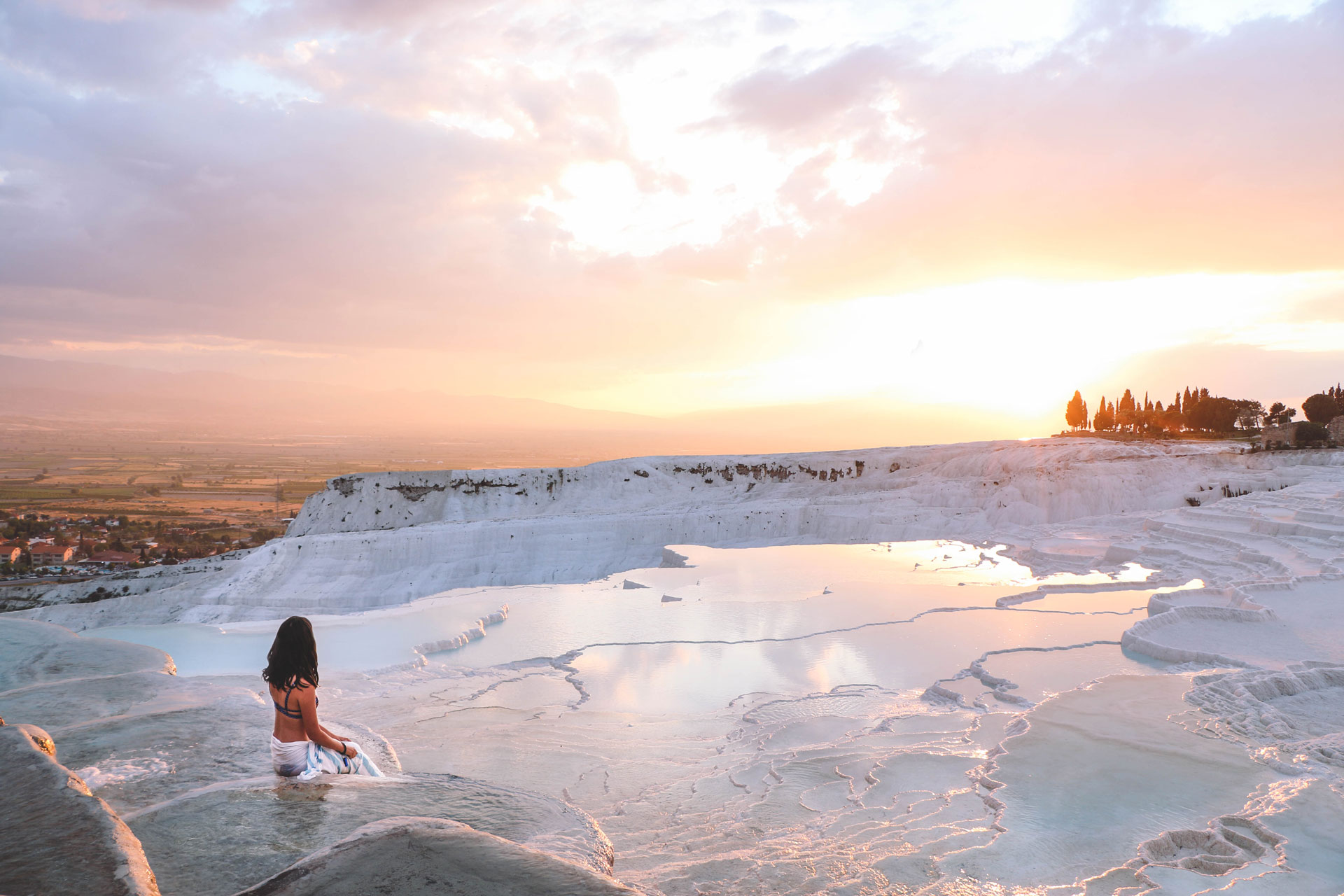
As the beauty of the day disappears beyond the horizon…
I wonder what kind of magic the night will bring…
– The Hidden Thimble
A Little Bit Of History
As one of the rarest geological phenomenon’s on Earth, Pamukkale’s travertines are fascinating. What exactly are they? How was something so big created? Where do the hot springs come from? Does the water really have healing abilities?
Never fear, everything you ever wanted to know about the Pamukkale travertines will be answered in this post!
Pamukkale means “Cotton Castle” in English
Let’s begin with Turkish mythology. Turkish legend has it that Pamukkale’s travertines were formed long ago by giants who they left their cotton harvest outside to dry. The harvested cotton solidified and formed the ‘Cotton Castle’ we see today.
Realistically though, it’s creation is even more wondrous than that. When you think about it, the Earth and science are also very magical things, just like the story of the giants. The travertines first started forming about 400,000 years ago, after a series of earthquakes caused thermal waters to flow down the mountainside. These mineral rich waters deposited a sludge like substance called calcium carbonate – you can feel it under your feet when you swim in the pools. Being exposed to the sun, the calcium carbonate was simultaneously evaporated and crystallised into terrace like formations. The result? Magic cloud like-thermal pools you can swim in!
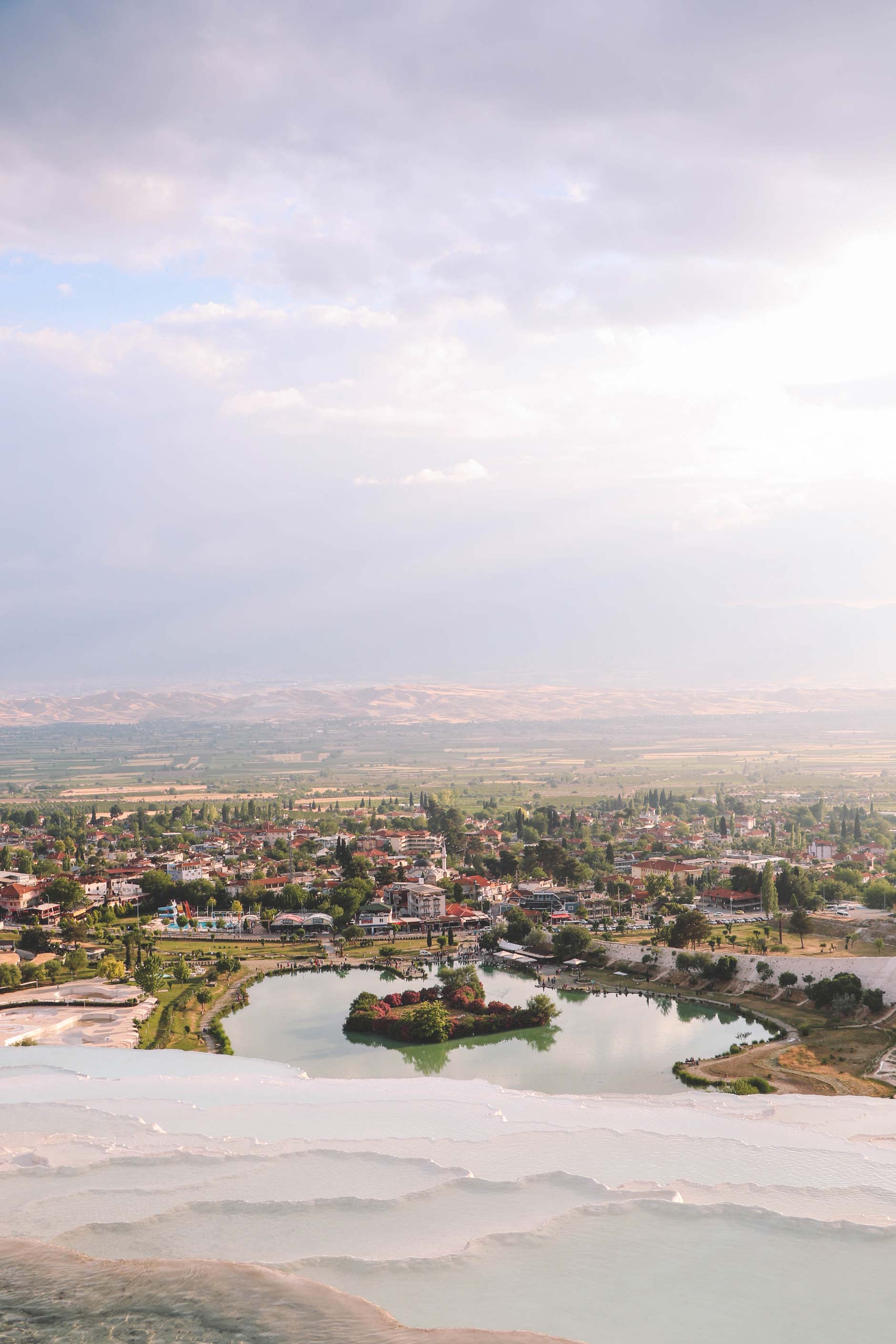
Things to see and do near the travertines
While explained in detail in my 24 Hours in Pamukkale post, here’s a short list of the things you can do in close vicinity to the travertine site:
- Walk through the ancient city of Hierapolis
- Visit the Hierapolis archaeological museum
- Take a dip in the Antique Pool (also known as the Cleopatra pools)
- Walk along the travertines and take a swim in some of the pools
- Catch the sunset over the travertines (photography guide below for those interested – my favourite photos are from sunset!)
- Paragliding
- Professional photo services – there are two photography services offered where you can get ‘professional photos’ taken. There is one at the top of the Pamukkale site, near the food, and one inside the Antique Pool area.
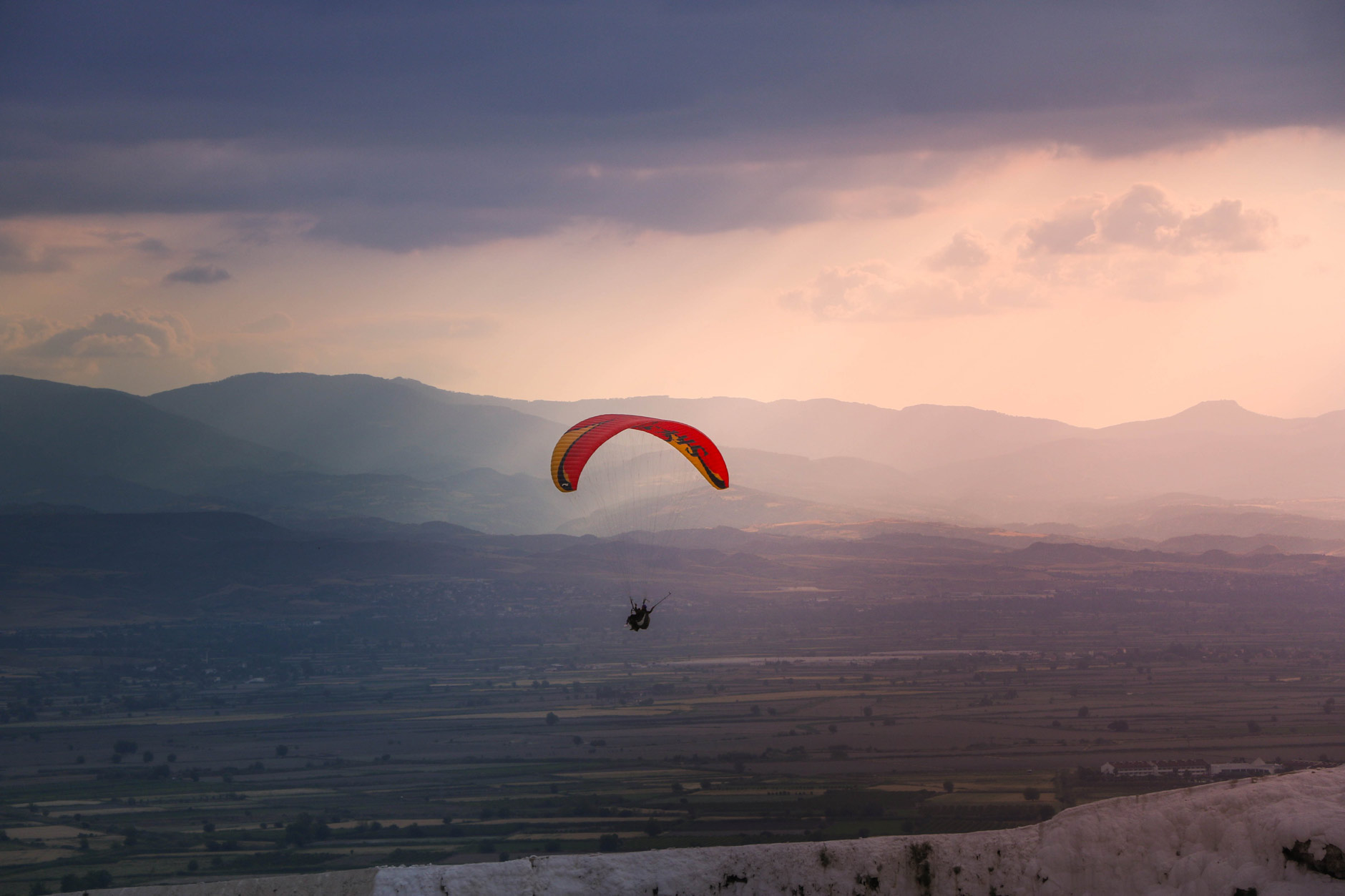
Tips and TRICKS
1. How to Get amazing photos WITHOUT crowds
When the locals told me that Pamukkale was the most spectacular at sunset I made sure I got myself a good spot for photos. And the locals couldn’t have been more right – it was absolutely gorgeous!
Here are my tips to get the perfect shot:
- Visit out of season. I visited Pamukkale from the 11th – 13th May and although considered the ‘shoulder season’ (the town was very quiet and sleepy according to the locals), the travertines themselves were packed! If you really want photos with no one in them – especially in the pools you can swim in – I would visit in winter.
- Try the North Gate Entrance: If you’re a really keen bean (I actually didn’t know this and I’m pretty bummed I didn’t!) Pamukkale’s North Gate apparently opens at 6am instead of the 8am opening times of the other two gates. This means you can get in before the crowded tour busses and get all the photos you could dream of! This entrance is only accessible by car though.
- Stay until sunset: The locals were definitely right, sunset is the most beautiful time to capture the travertines, so you definitely want to make sure you claim a good spot well before. The pools mirror the pastel colours of the sky and it is absolutely amazing to watch.
In May, sunset was a little later (around 7:30-8PM) and interestingly, some of the tour buses stayed back this late, so there were still quite a few tourists around. - Set up at least 40mins before sunset: As a solo traveler, it is definitely more difficult to take those ‘instagram-worthy’ shots of yourself amongst the beautiful sites you see. So a lot of the success of your photos comes down to preparation and planning. I reserved a spot about 40minutes before sunset. This allowed me to set up all my gear (tripod, remote and camera) as well as do a few test shots before the crowds came to watch the sunset.
- Shoot from the area that’s closed off to tourists: For preservation purposes, the most beautiful areas of the travertines are closed off to tourists, meaning you can get a clear shot of them at sunset without anyone in the background. Yes it does mean you can’t get a shot of you swimming in them, but you are allowed to sit on the outer pools, which still creates a magical shot – see below!
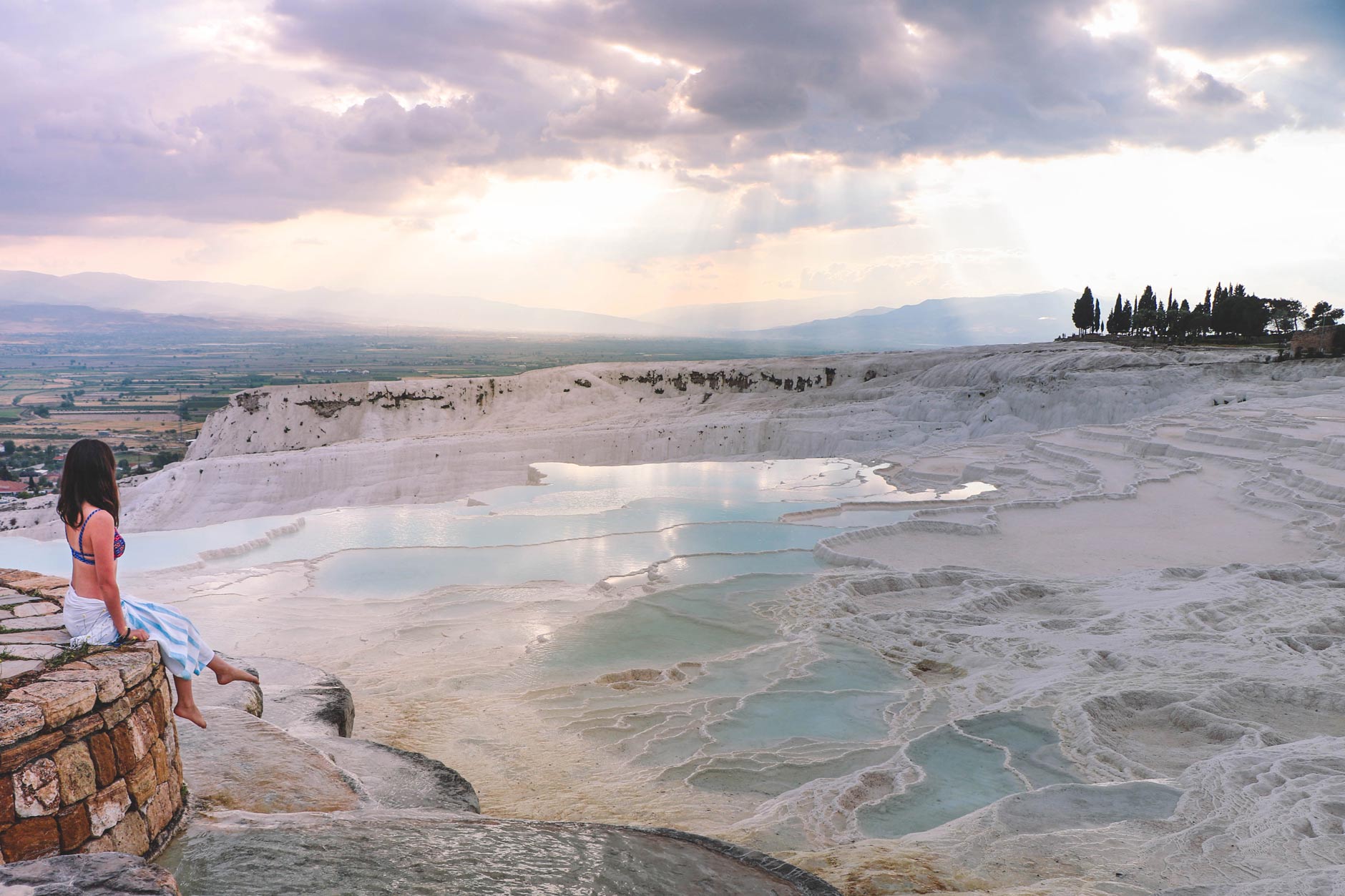

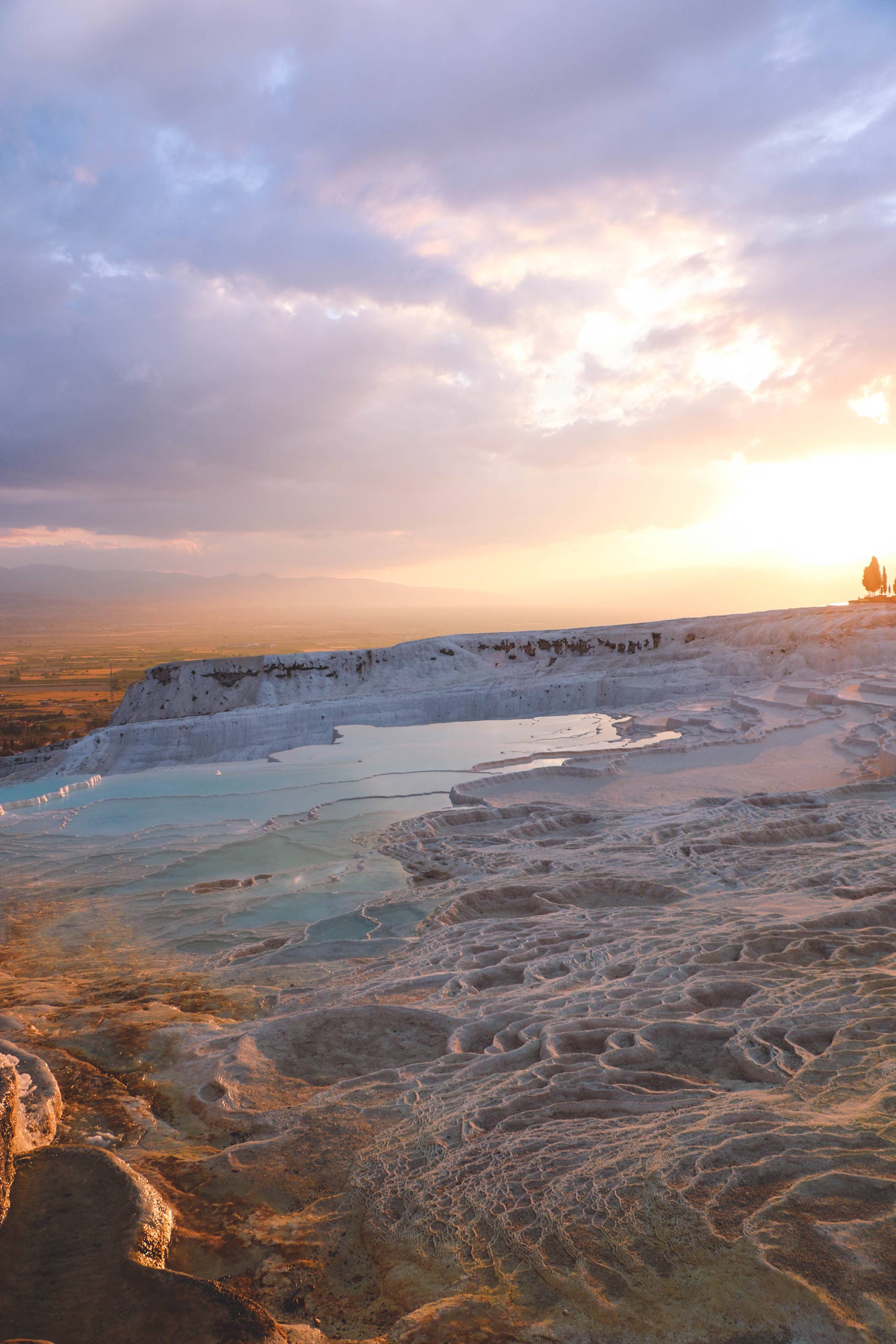
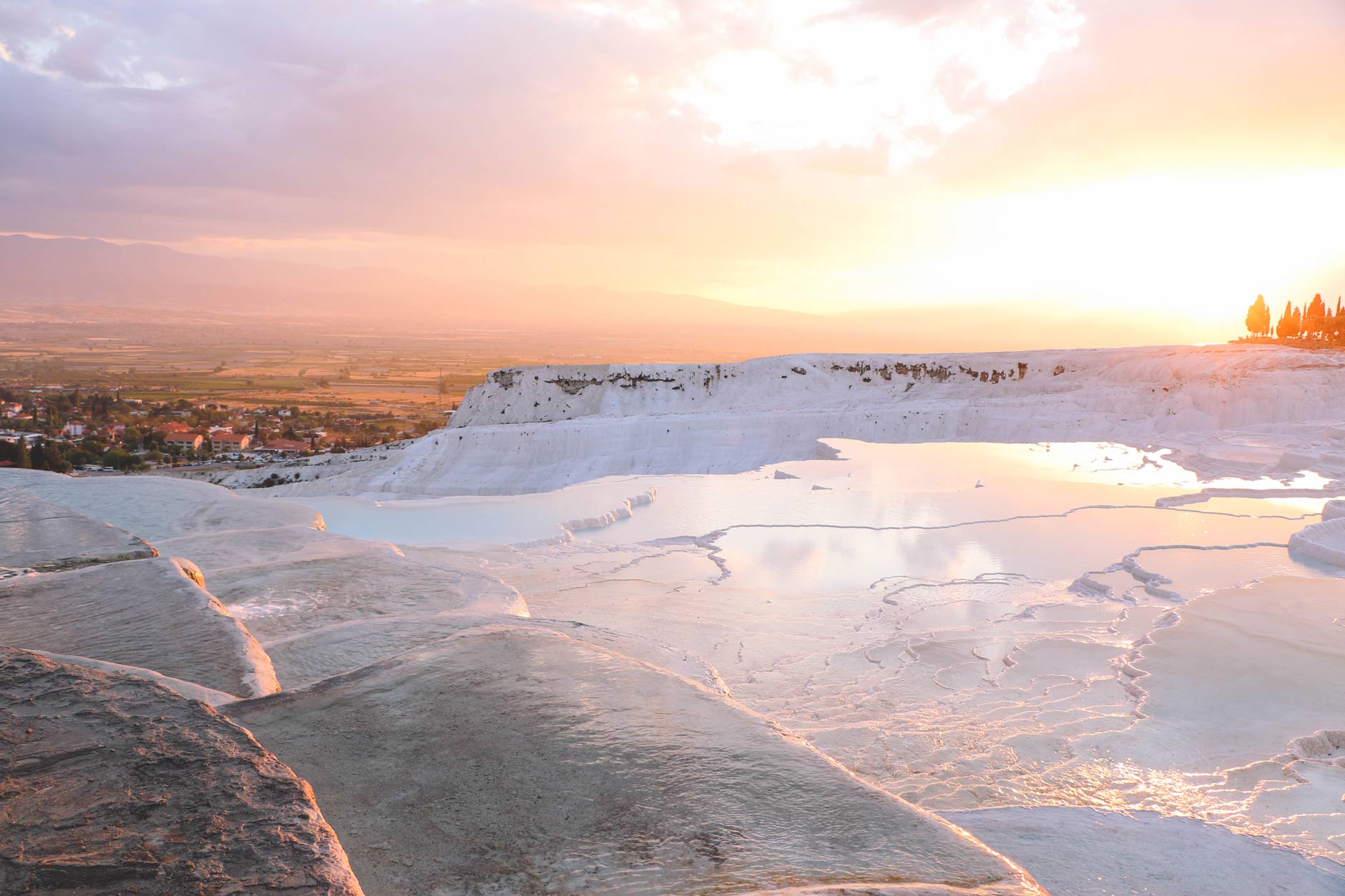
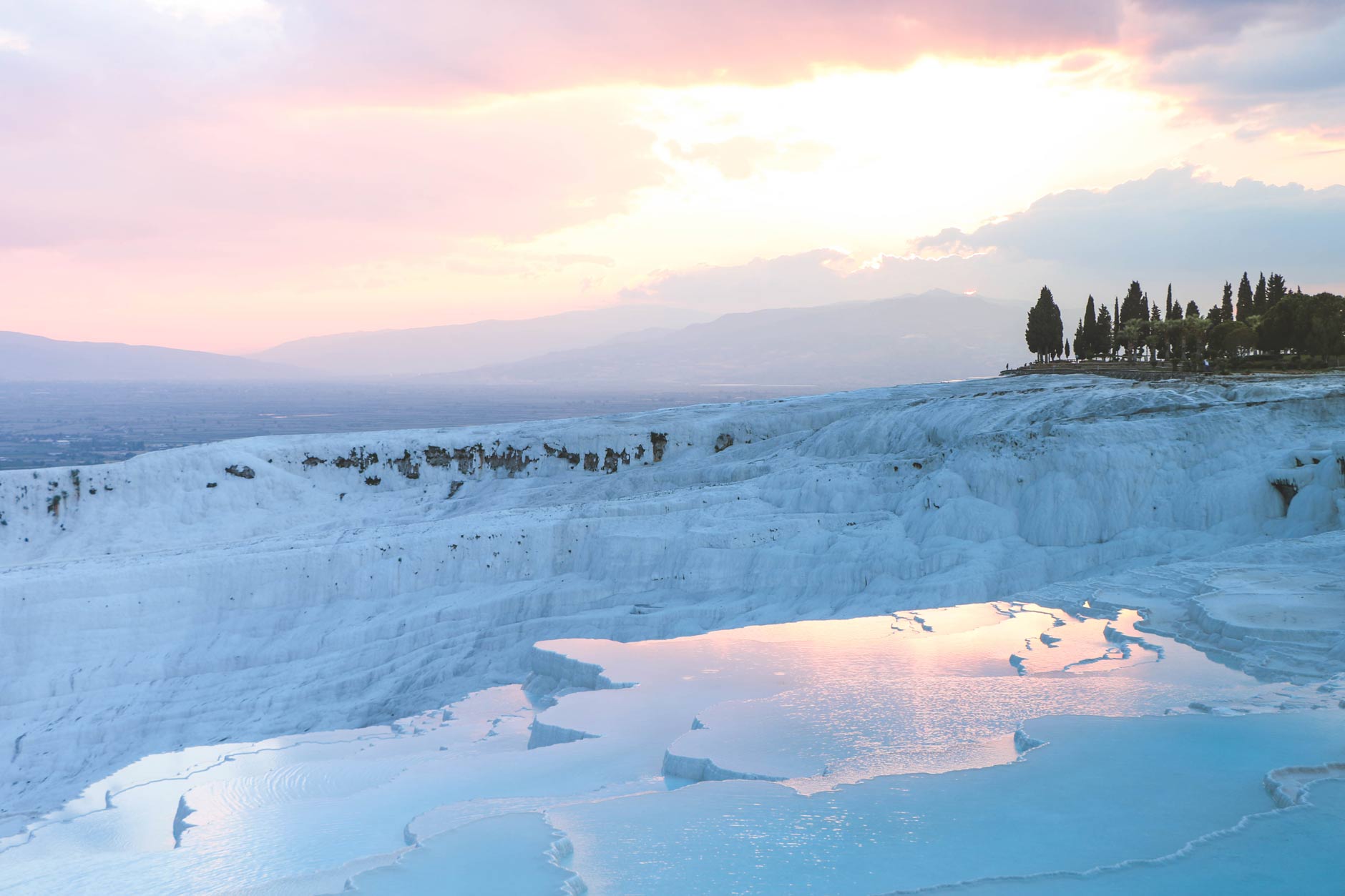
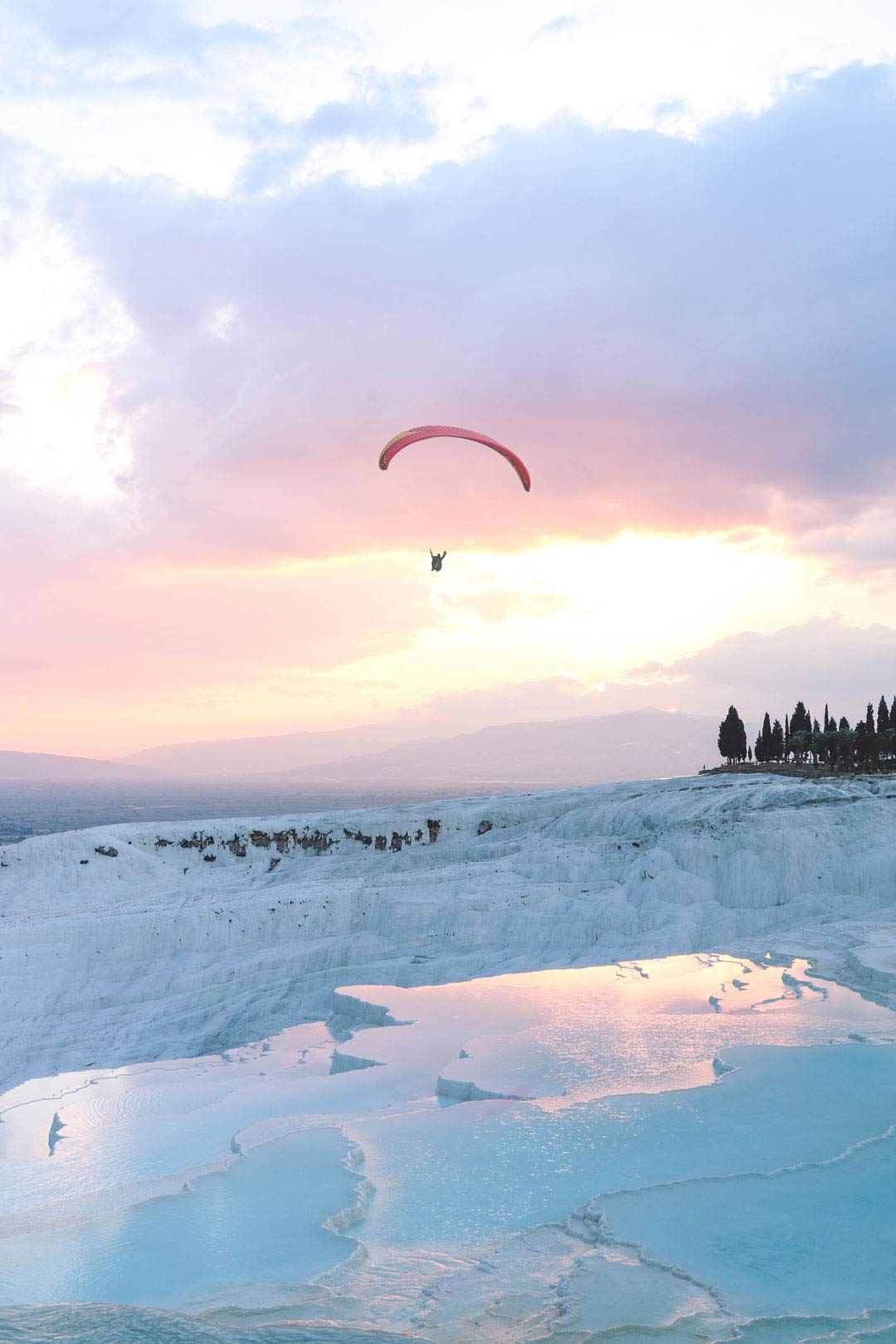
2. The site Doesn’t look like the pictures you see online
I know, I know. The photos I’ve shown so far say the opposite to what I’m claiming above, but I’m going to expose to you below what MOST of the site actually looks like.
To be honest, when I first arrived, I couldn’t help but feel a little disappointed because of how differently the site looked to all of the advertising brochures and images you see online.
Majority of the travertines are completely dry.
Because of this, you can’t help but feel like you’ve been lied to. Don’t get me wrong, it’s still really beautiful, but the beautiful images you see in guidebooks and tourist websites that show people swimming in an abundance of overflowing travertines is a LIE. These images are from wayyy back in the past when these areas were still open to the general public. Since then, they have been been closed and ‘dried out’ to allow the travertines time to recover from the terrible treatment of the tourism industry.
To give an example:
Media images look something like this:
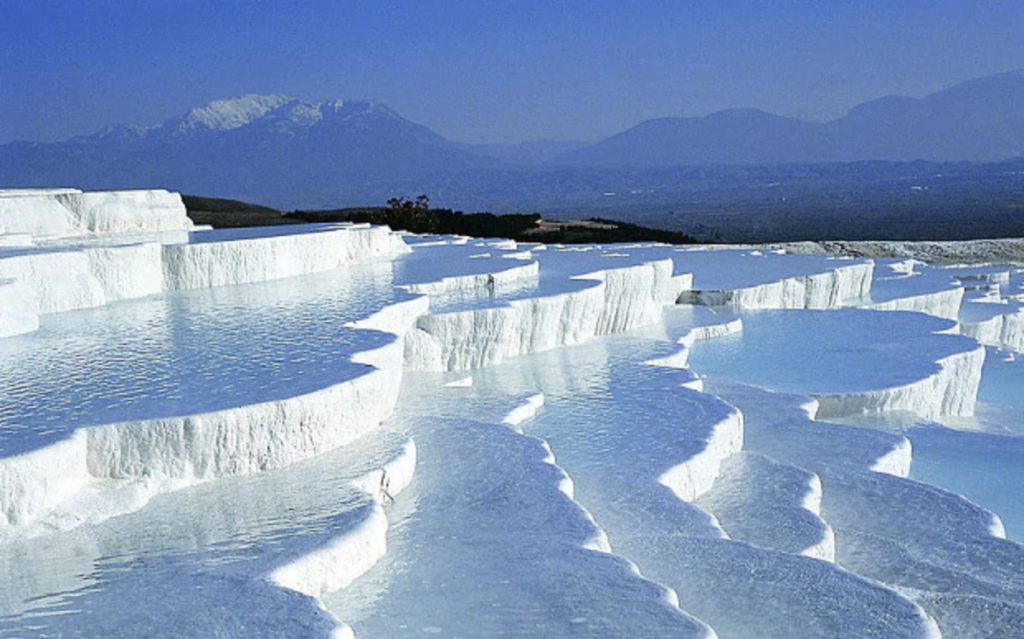
But the site actually looks more like this:
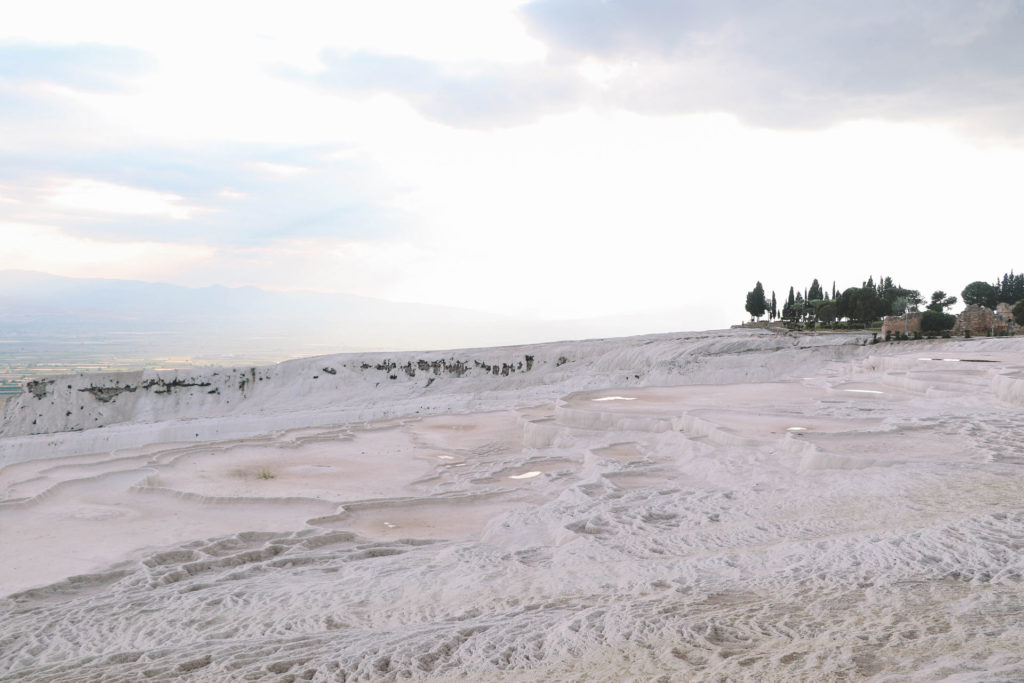
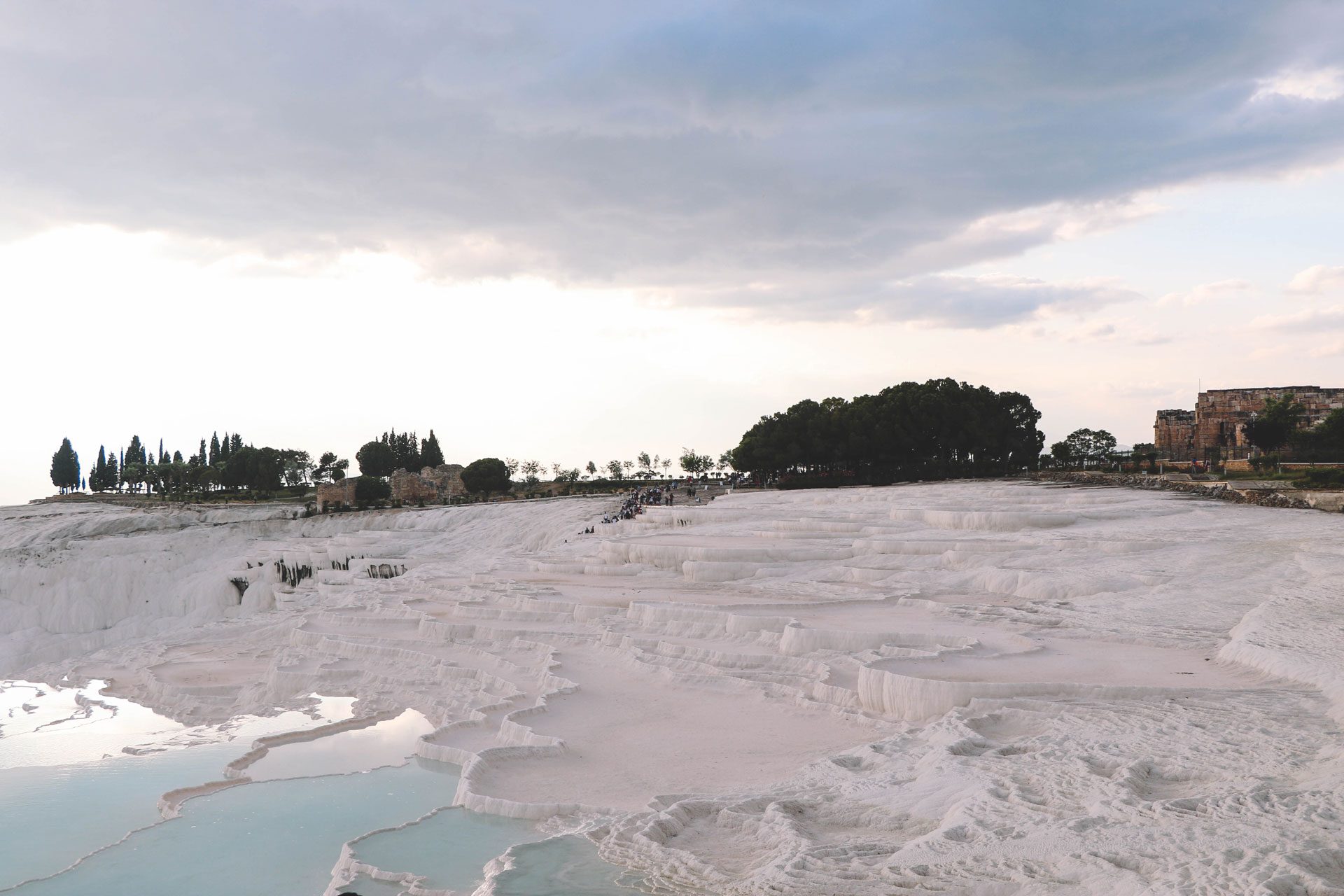
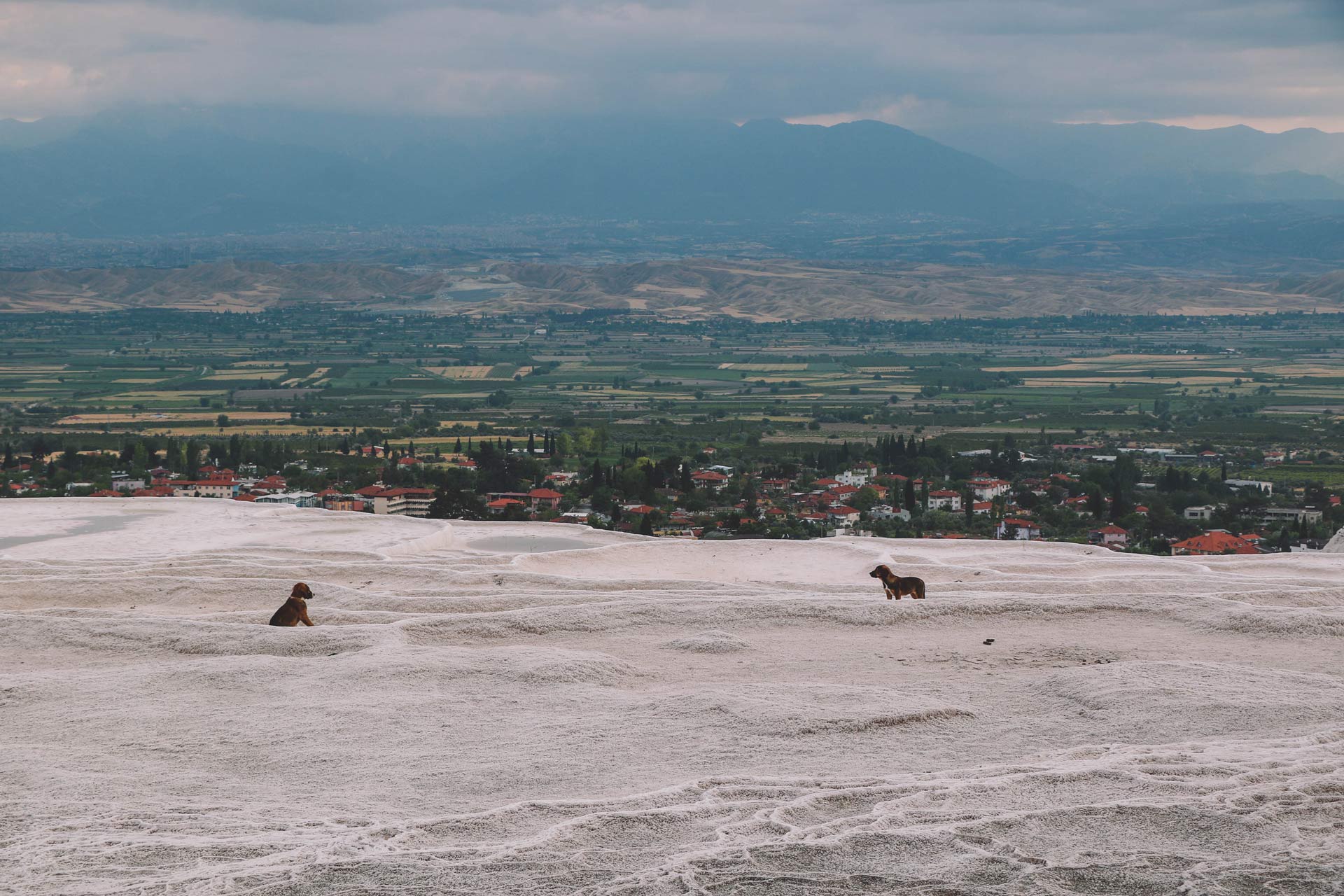

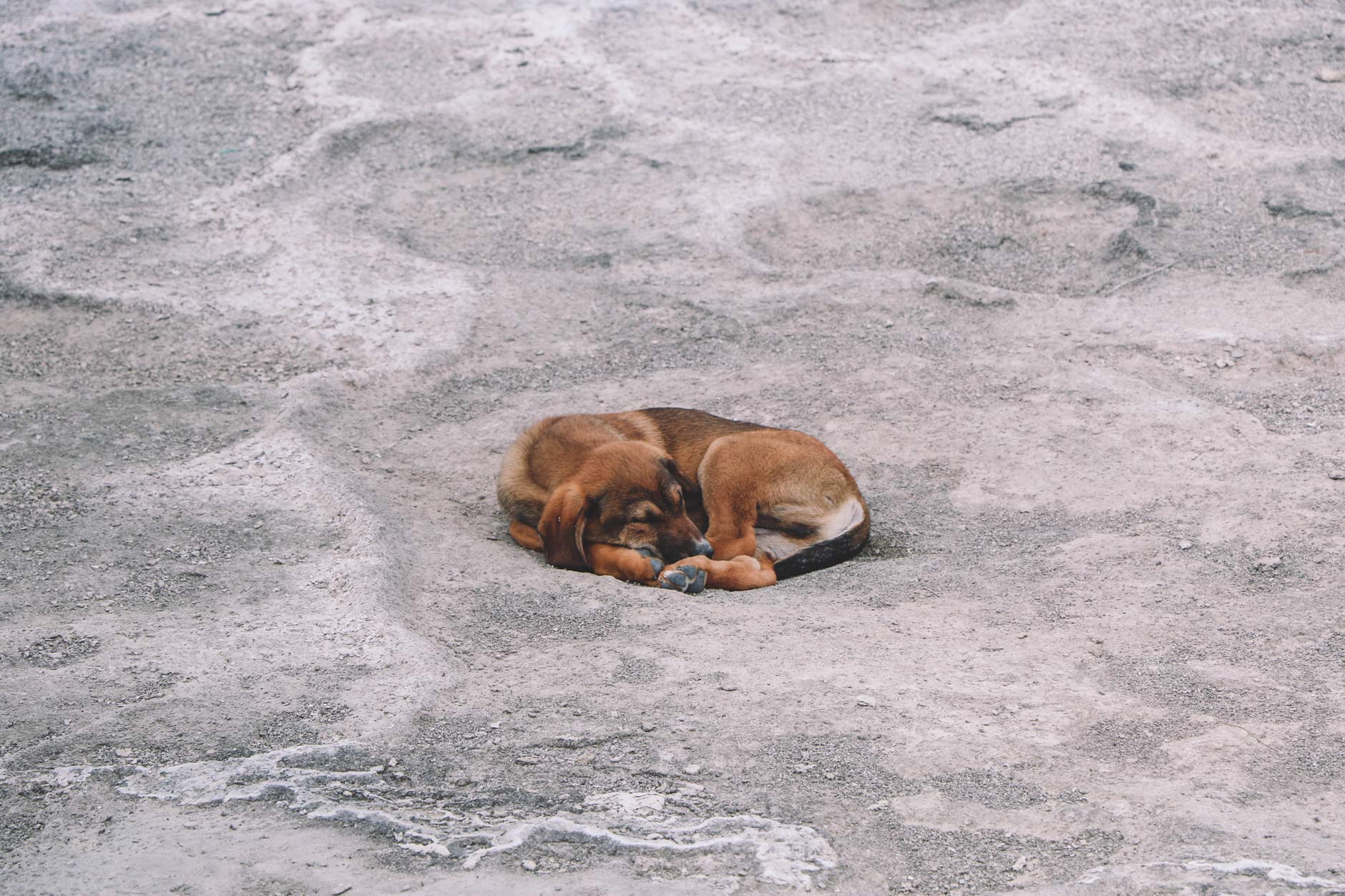
3. You Can’t Swim in most of the travertines
Any travertine not located along the main pathway is off limits to visitors. There are only about 3 or 4 large travertines available for the public to swim in, and they are packed with tourists.
Over the years Pamukkale has faced a lot of damage from the tourism industry – there even use to be hotels that were built on top of the ancient city of Hierapolis, which destroyed some of the ruins back in the 1960s. Some hotels back then even used the thermal water in their own swimming pools and even the tourists feet trampling all over the travertines has caused significant damage. As a result, most pools are dried out and closed off the the public.
Heres a comparison from past to present:
Media images look something like this:
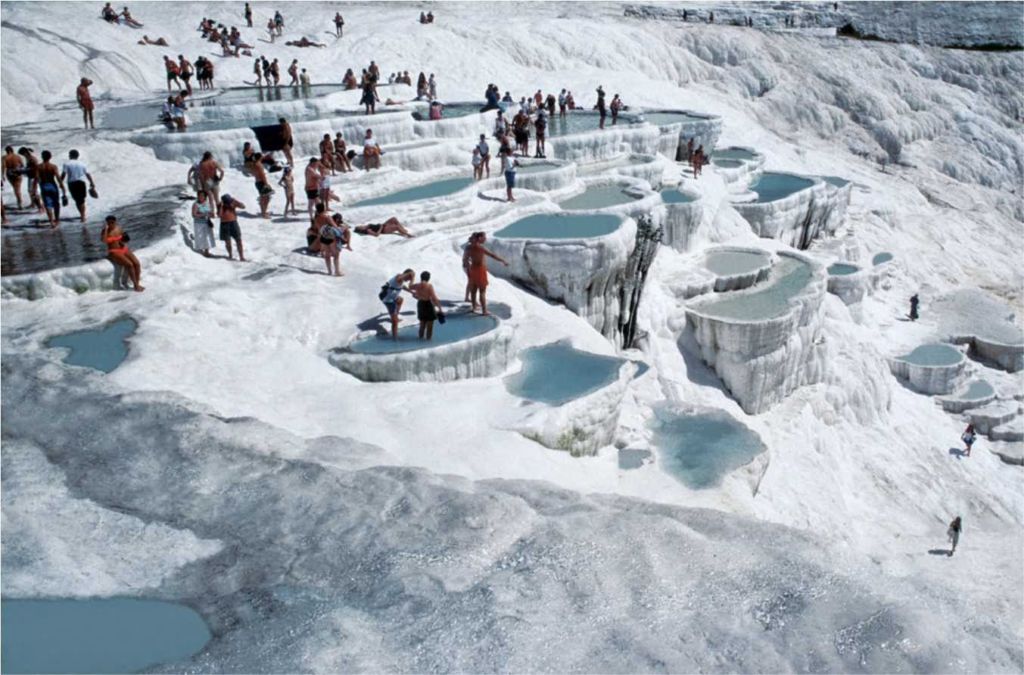
But here is a more accurate picture of the pools you can swim in:
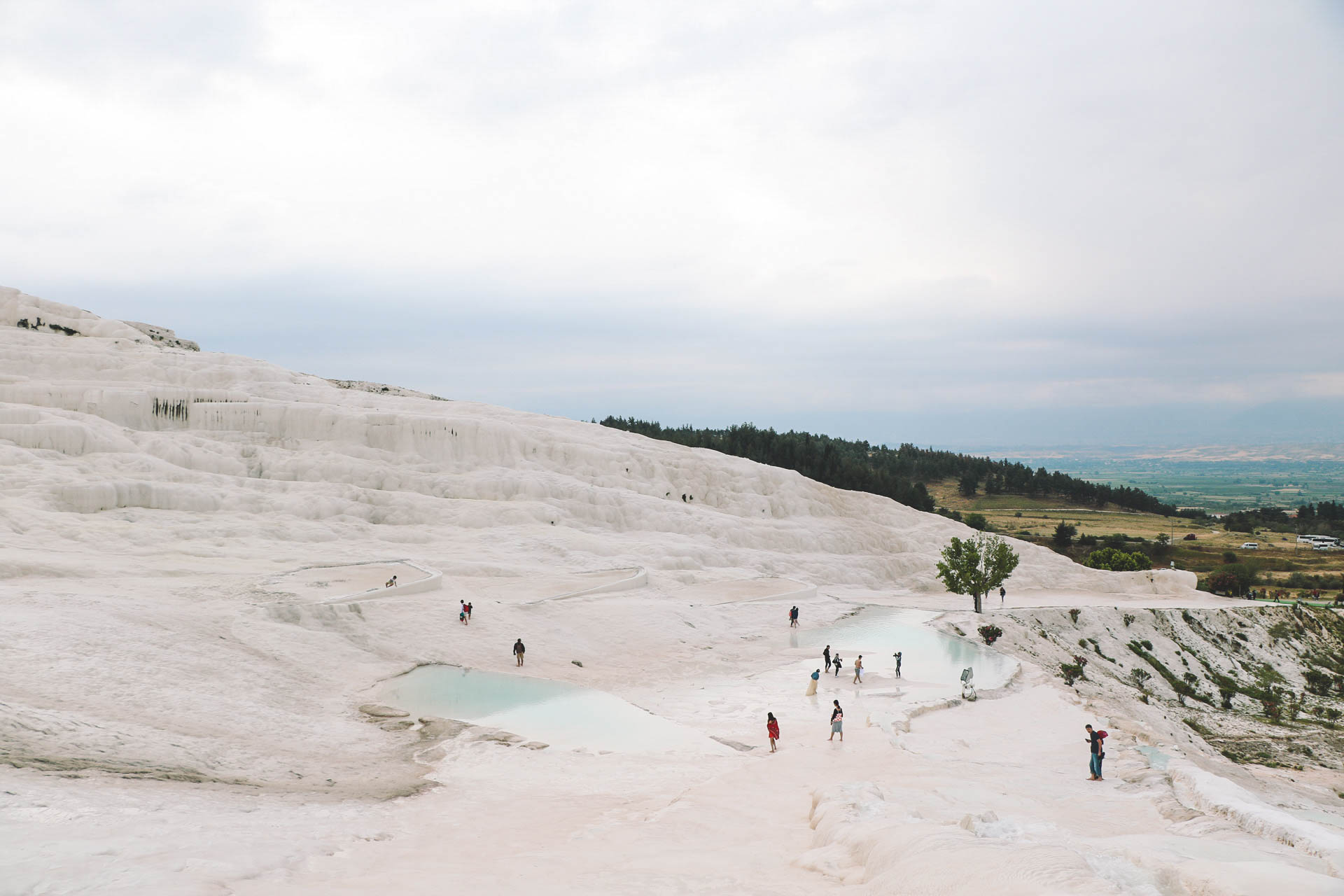
Oh and you might want to get there early…:
Crowds at opening time (8AM):
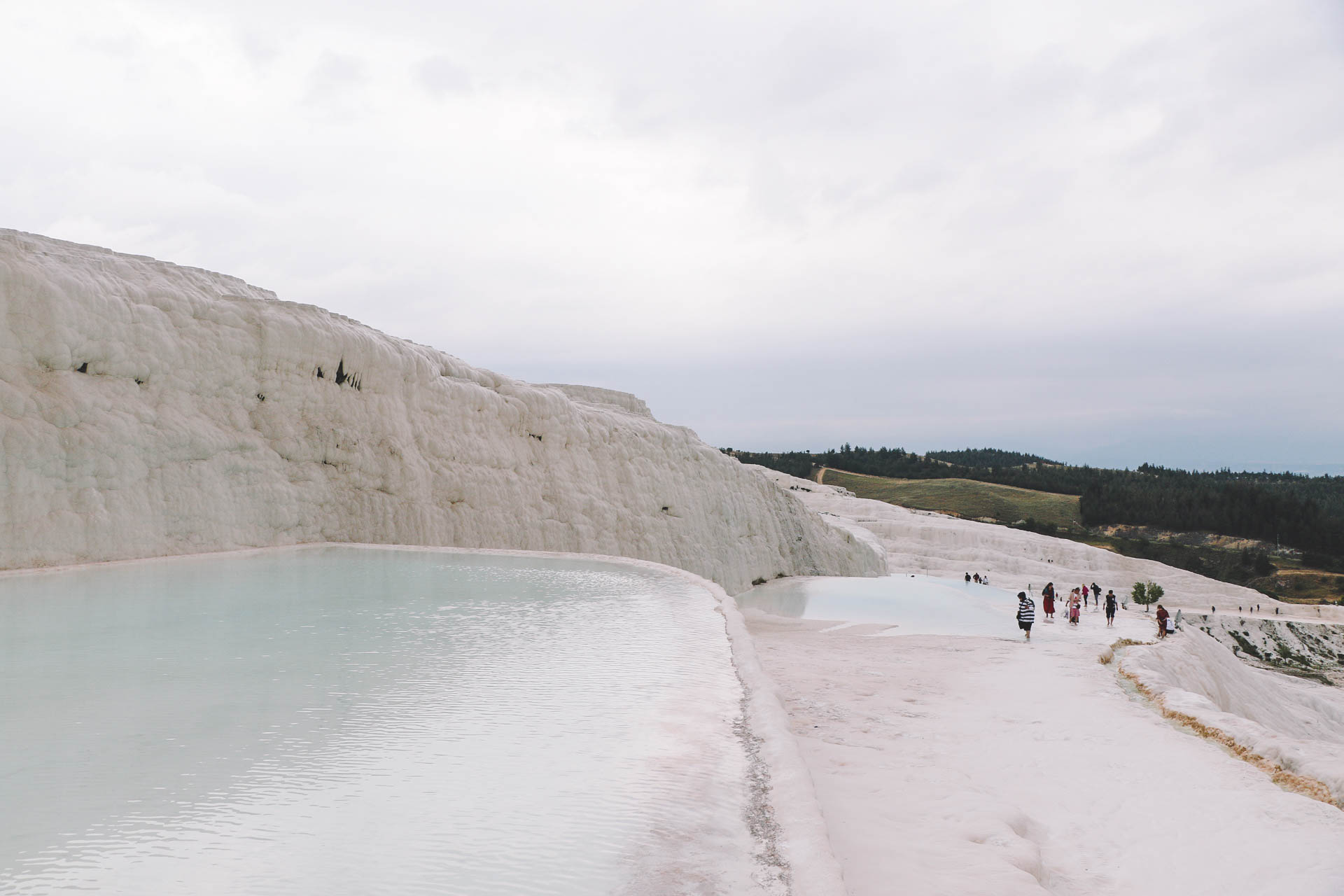
Crowds just 40 mins later….PACKED!!
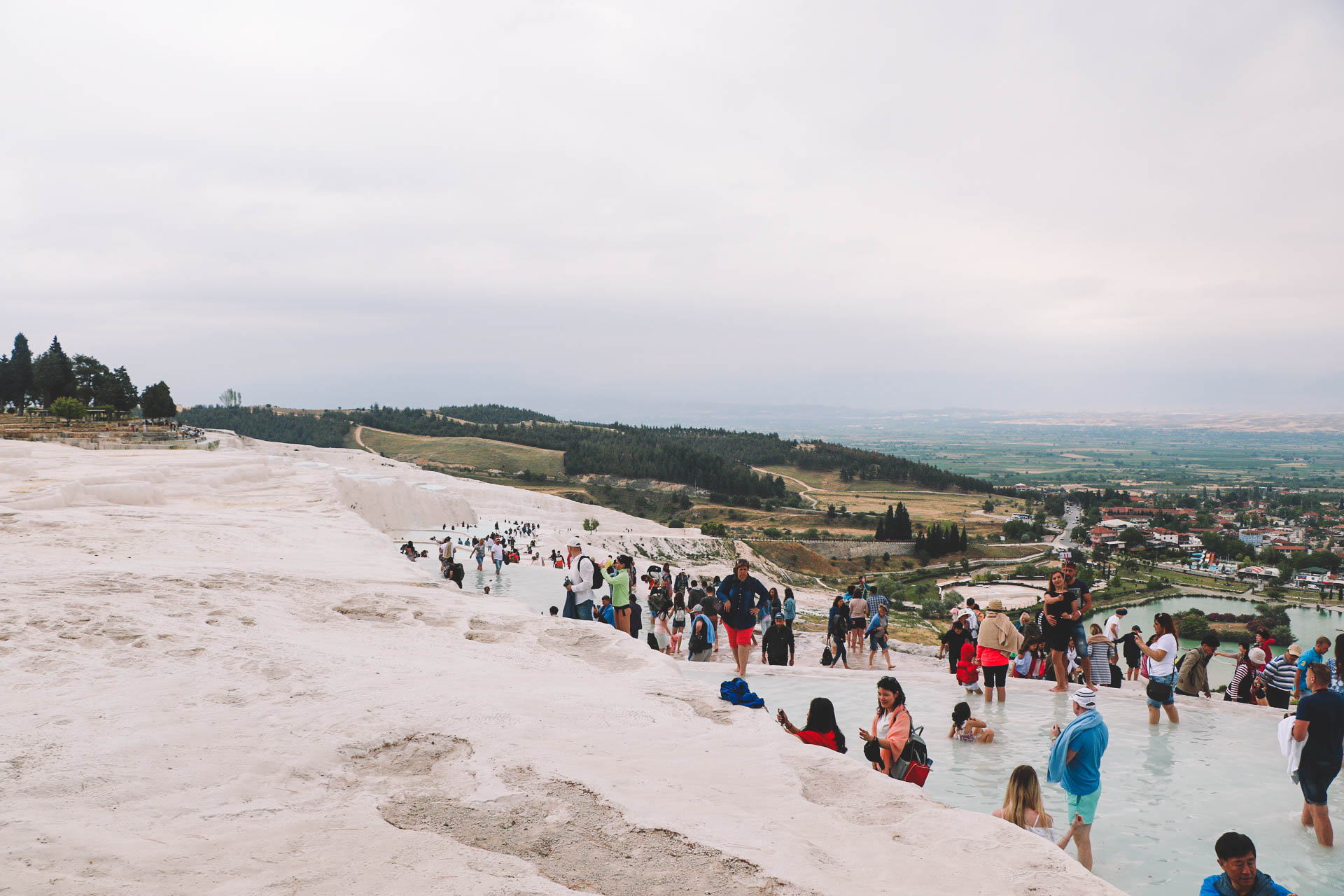
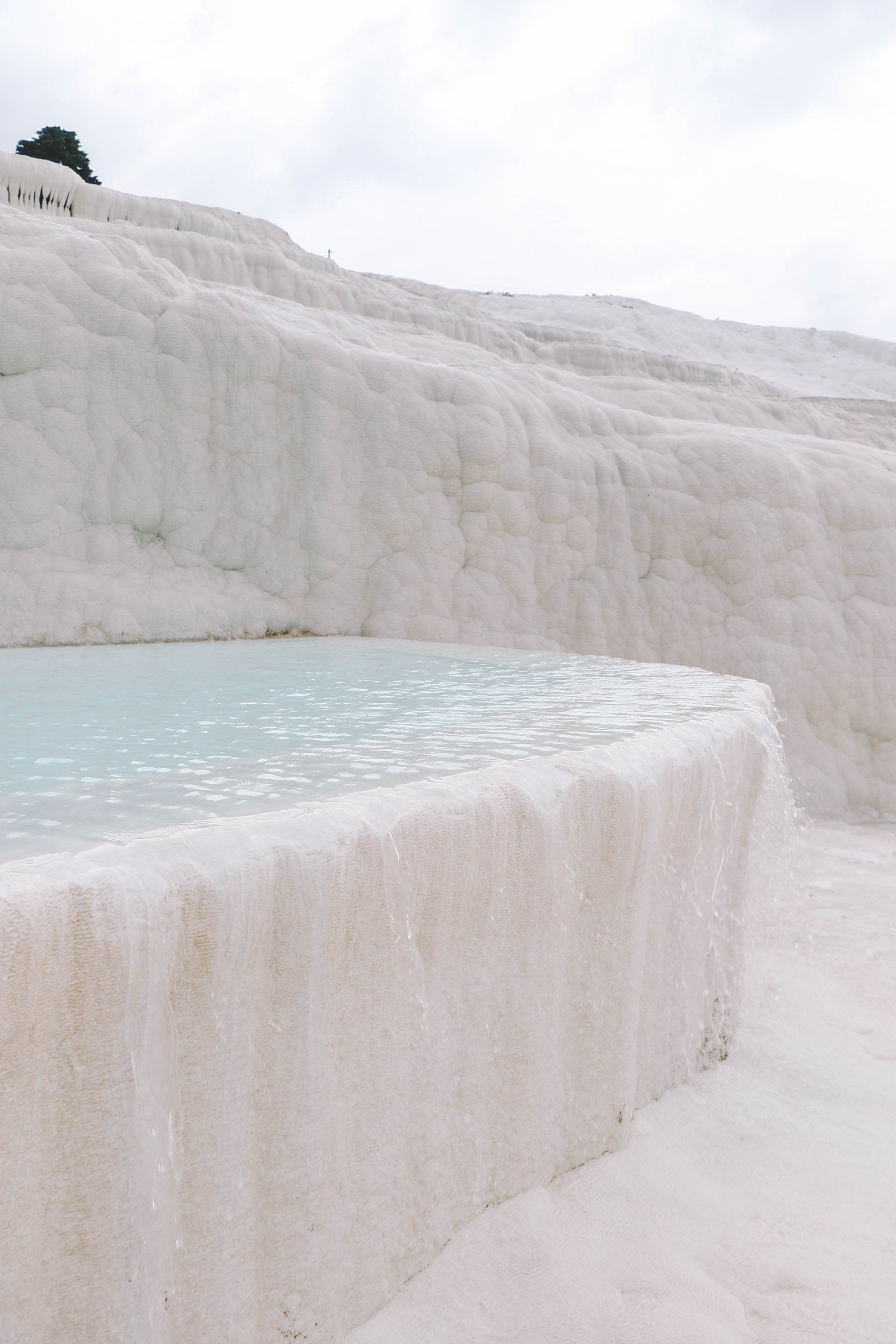
4. The water has healing powers
The thermal waters are high in minerals and are known to cure a variety of diseases. I had so many locals tell me about success stories they had witnessed. Some of the many diseases the thermal waters claim to cure or benefit include:
- Asthma
- Rheumatism
- High blood pressure
- Circulatory issues
- Overall good for skin and eye disorders
- Kidney stones
- Stroke
- Physical exhaustion
- Digestive issues
- Nutritional disorders
5. Consider what you wear
Plan for getting wet, especially if you enter from the town entrance like I did. It involves a walk up the travertine pathway, which has water running down it.
To minimize damage from tourists, you are also required to remove any shoes, and contrary to how the travertines look, the rock is actually quite pointy and slippery under your bare feet which makes climbing up from this entrance rather uncomfortable!(In the travertine pools though, the floor is soft thanks to the build up of the sludge-like calcium carbonate)
You don’t want to be wearing long pants and lace up shoes with socks. Ideally dress for the Pamukkale travertines as you would the beach – thongs (flip flops for the US people, yes in Australia we call them thongs), swimmers and something light on top (think a beach dress, or a simple T-shirt and boardshorts). A backpack that’s waterproof is also ideal.
Turkey is predominantly a muslim country, so remember to be respectful and cover up to an extent. I’m not saying you can’t wear a bikini when you go swimming – you can, but let’s not take it to the Brazilian bikini level trend that seems to be everywhere now (at least in Australia). You know the ones where your bikini bottoms are basically a g-string.
6. Take the best Entrance FOR YOUR NEEDS
Pamukkale has three entrances;
- The North Gate: This gate requires a car to get to, but it apparently opens at 6AM if you’re looking to get into the heritage site early to beat the crowds or to take photos. The entrance starts at the beginning of the town of Hierapolis, so you need to walk through it before you reach the travertine site – it’s quite a far walk if you’re not prepared! The gate does get quite busy later in the day.
- South Gate: This gate requires a car to get to if you’re staying in town. It opens at 8AM and is the most popular (and busiest!) entrance to the travertines. All the tour buses drop people off here. At this entrance you start at the top of the travertines.
- Town Gate: This is the easiest gate to enter the travertine site if you’re staying in town and opens at 8AM. It’s a lot less crowded way to view the travertines from 8AM, than to start at the North gate as you’ll find most of the crowding occurs there.
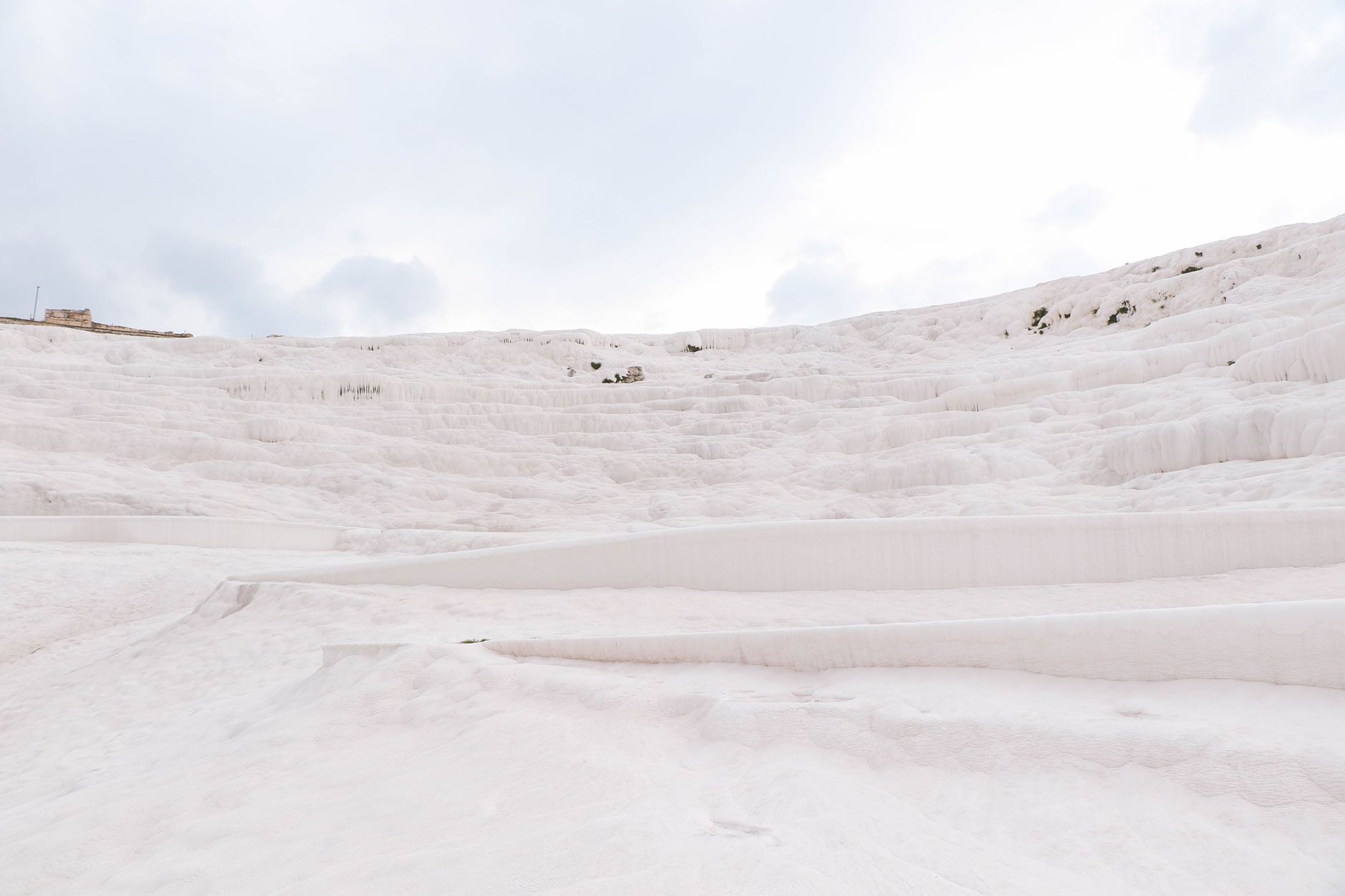
GENERAL INFO
How to get there
Detailed info regarding plane and buses from other areas of Turkey to Pamukkale can be found in this post: 24 Hours in Pamukkale
If you’re staying in the village of Pamukkale itself, you literally can’t get lost walking to the travertines, it’s the biggest thing you can see in the skyline and at most is a 20 min walk.
PRICE
Entrance Cost for Pamukkale Travertine (B on map) and Hierapolis Ancient City (1-16 on map): 35 Turkish Lira
Entrance Cost for Cleopatra/Antique Pool (A on map): Free to go inside the complex, to swim you need to pay 32 TL (Adults) 12 TL (Kids 6+) Kids (<6) Free.
OPENING HOURS
North and Town Gates:
From April 15 till October 2 – Open from 08:00 to 21:00 every day
From October 3 till April 14 – Open from 08:30 to 17:00 every day
South Gate:
Apparently the South Gate opens at 6AM. I didn’t know this prior to my trip, so I didn’t get a chance to verify for myself, but I read this was possible online. You will need a car to access this gate.
FACILITIES
Disabled Access:
The travertine site itself is not wheelchair friendly, however if you enter from the North entrance, you will be able to view the travertines from the top paved areas.
Toilets:
Toilets, change rooms and showers are available on the site. The latter two are only accessible inside the Antique Pool complex.
Food:
You can buy food until closing time at the Pamukkale site. There’s quite a few options, but it is a lot pricier than in town. A LOT PRICIER!!
Parking:
The South and Town gates have free parking – it gets filled really quickly though! Parking is also available at the North Entrance for a small fee.
Lockers:
Lockers are located in the Antique pool complex. You are required to give a small deposit, which you get back when you finish.



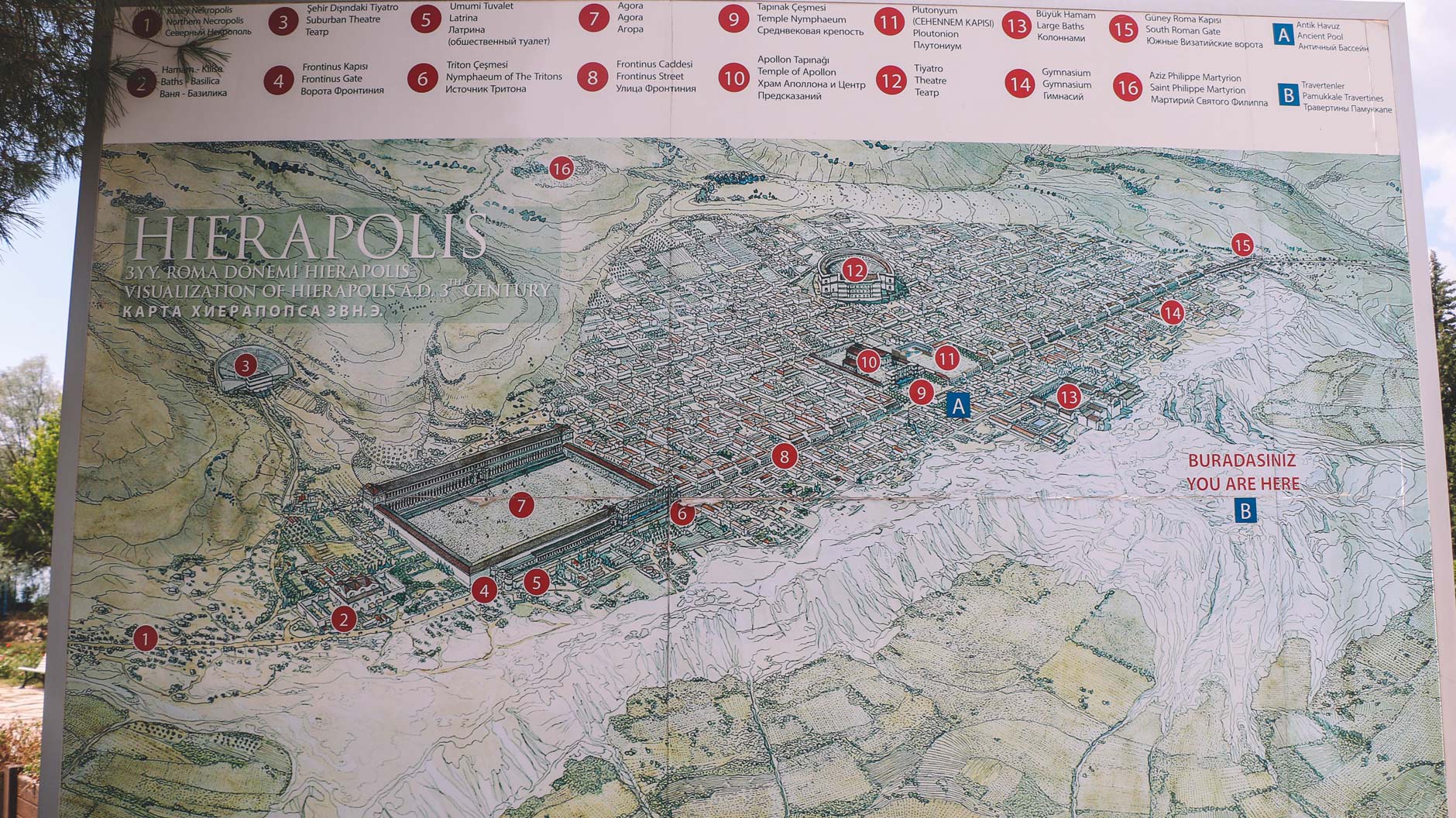
Wow, now this is what I call absolute beauty. Love these views. Such a cute legend. I’d love to visit Pamukkale Travertines. So pretty and dreamy. I love hot springs and in Canada I went to scandinavian spas with thermal springs. When I lived in Japan for a year I also went weekly to the hot springs, and totally miss it. I’d love to just sit there with that incredible view!
Xo,
Miki
http://mikialamode.com
Hi Miki! Definitely a natural beauty! And yes, I thought the legend was super cute too! The area is primarily known for its cotton production, so that also added a cute spin to the story as well.
YES! Visiting an Onsen in Japan is one of the things I really want to do!!! I missed it on my first trip, but next time I’ll definitely go!
The Candian hot springs sound great too, Canada is also on my list – it looks absolutely stunning xx
Looks amazing place and pictures are stunning!
Mira Audrey’s
Thank you Mira!
Hi Talyssa, your post was so helpful while im screening around about information of which gate is preferrably accessed.
By the way, as per my research, the “town gate “which is opposite “White Dragon Chinese and Turkish Cruisine” restaurant and opening also started at 8AM as North Gate but less crowned compare to Notrh Gate.
Base on your verification, the South Gate is earlier opening at 6AM indeed and start from Hierapolis to reach the Travertine,
So can i know exactly location on Google Map for of South Gate to help me easily distinguish with others two gate ?
I definately will consider either early morning South Gate or late afternoon for sunset view of this place ^.^
Hi Kon, so glad you found the post helpful! Here’s a link to the south gate, I will update this blog post with a map in the near future!
https://www.google.com/maps/dir/Pamukkale,+20190+Pamukkale%2FDenizli,+Turkey/south+gate+pamukkale/@37.9269963,29.122176,3534m/data=!3m1!1e3!4m13!4m12!1m5!1m1!1s0x14c713c95620da2f:0xb1190f5f451efcd6!2m2!1d29.1187097!2d37.9136957!1m5!1m1!1s0x14c7122591be579d:0x9da38f7a28cf1a69!2m2!1d29.13133!2d37.923131
Hi,
Please update this as the information is wrong. You have mixed up the north and south gate (as I found out when I followed this and so drove to the North gate so I could get to the travertines quickly…. ) but the north gate is the one furthest away.
Hi Aisling,
Omg, thank you. I just double checked and you are correct! I have ammended the post with the correct info – so sorry for my mistake, I must’ve confused them when writing that part at the bottom of my post. I hope the mistake didn’t impact you too much. I’m so mortified. Thanks so much for alerting me though. I really appreciate it because I always want this blog to be as accurate as possible!!